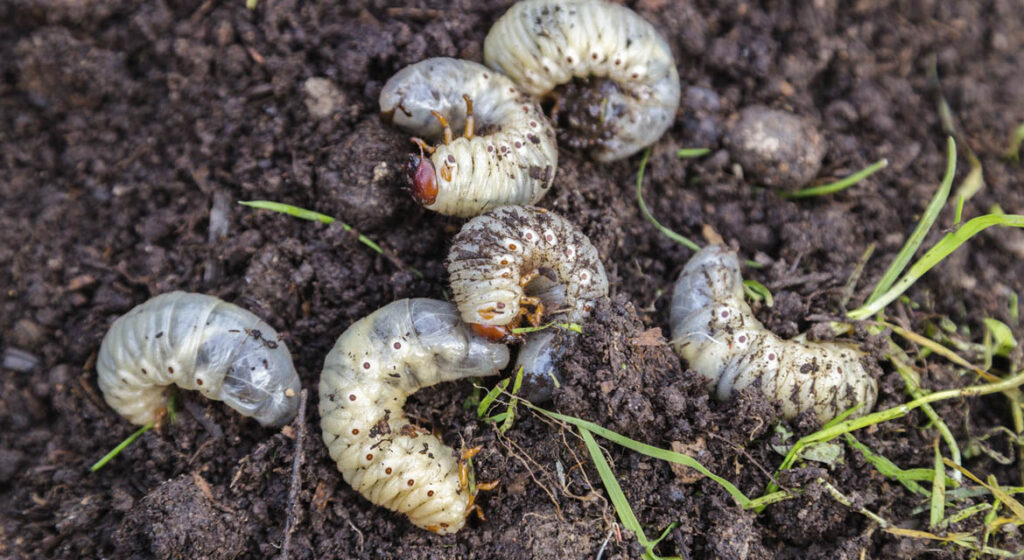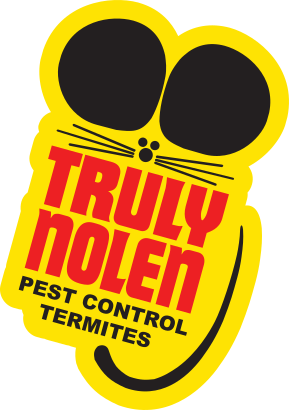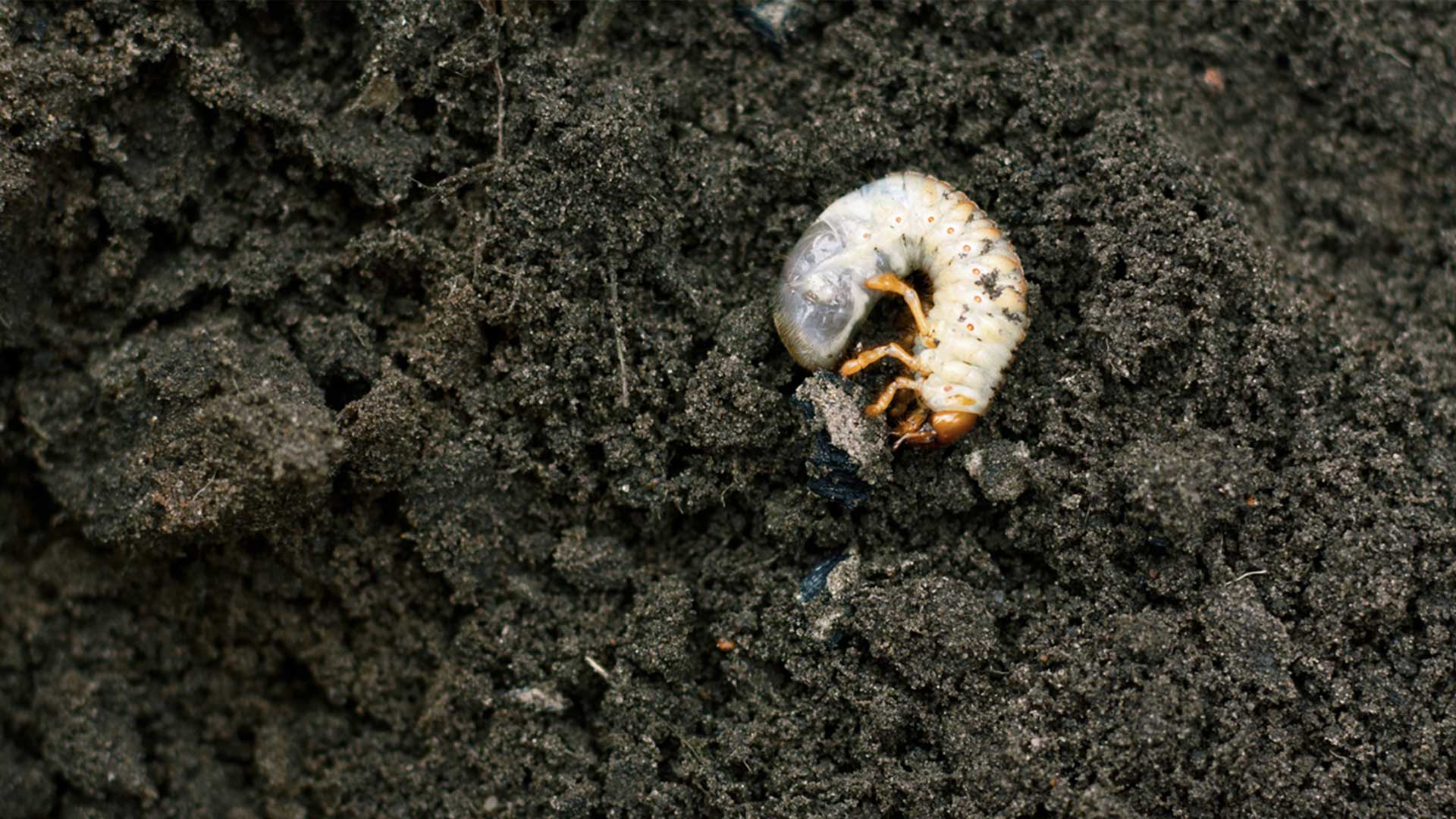
How Do Grubs Damage My Lawn?
Have you noticed brown patches or wilting grass in your lawn? If so, grubs may be the culprit. Grubs are beetle larvae that can cause extensive lawn damage by feeding on the grass’s roots. Here are three key points to keep in mind:
- Grubs damage lawns by feeding on the roots, hindering the grass’s ability to absorb vital water and nutrients.
- Signs of grub damage include brown, dead patches that resist recovery and wilted grass that easily detaches from the soil.
- Lawns with grub damage become more vulnerable to other problems like drought stress, weed growth, and disease, exacerbating the overall health and aesthetic of the turf.
Grub Infestation Overview
A grub infestation can be detrimental to your lawn’s overall health. Too many grubs in one area can quickly decimate an entire lawn, leading to dead patches that require reseeding or sodding. If left unchecked, a grub infestation can cause severe damage that may take years to undo.
Fortunately, controlling grubs is possible through various methods, such as applying insecticides or using natural predators like nematodes. This article will explain everything you need to know about grubs and provide examples of effective grub control measures. With this information, you can prevent grub damage and maintain a healthy, beautiful lawn.
Identifying Signs of Grub Damage in Lawns
Dead patches in a lawn can be a frustrating and unsightly problem for homeowners. One of the most common causes of lawn damage is grubs. These small, C-shaped larvae feed on grass roots, leading to brown or dead patches in your lawn. Yet, other issues may cause dead grass. So you must be able to differentiate the signs of a grub infestation from other types of lawn damage.
Below we discuss the best ways to determine if grubs are the cause of your lawn problems.
Dead Patches in Lawns May Be a Sign of Grub Activity
One of the most obvious signs of grub damage is dead or dying patches in your lawn. These areas may appear brown or yellow and often feel spongy when stepped on. The unique texture occurs because grubs feed on the root systems of grass, causing them to weaken and die off. Without the root mat, the ground will be less compacted and move more as you walk.
If you notice dead patches appearing seemingly out of nowhere, grubs are likely the culprit. Act quickly if you suspect that grubs are damaging your grass, as they can destroy a lawn if the infestation is left unchecked.
Grubs Can Damage Root Systems, Leading to Lawn Damage
As we mentioned earlier, grubs feed on the roots of grass plants. As grubs eat away at the roots, it becomes harder for the grass to absorb nutrients and water from the soil, leading to a weakened and unhealthy lawn. This issue makes your lawn more susceptible to other problems, such as drought stress, disease, and weed infestations. Grub activity can cause large lawn areas to die off completely if left untreated.
In addition to feeding on root systems, grubs attract pests like moles and skunks who feed on grubs. These pests often cause further damage to the yard and make it even more difficult for you to save the grass.

Truly Nolen GUARANTEE
If you’re not completely satisfied, you’ll get a full refund on your most recent service with our 100% money back guarantee.

$50 Off Year Round Pest Control
Truly Nolen is a family-owned company with 85 years of experience providing the best pest control. If you’re not completely satisfied, you’ll get a full refund on your most recent service with our 100% money back guarantee.
Spore Disease May Be a Sign of Grub Problems in Home Lawns
The presence of spore disease can also indicate a grub problem. This fungal disease thrives in moist environments, and you will often find it in lawns with heavy grub activity.
Spore disease appears as small, white mushrooms or toadstools that pop up throughout your lawn. While the mushrooms will not necessarily cause damage to your grass, it’s a clear indication that there are underlying issues with the health of your lawn.
Identifying Signs of Grub Damage Early Can Help Prevent Further Disease and Damage
The key to preventing significant grub damage is early identification of their activity. Therefore, you should keep an eye out for dead patches in your lawn and be proactive about pest control measures.
If you suspect that grubs are damaging your lawn, you can take the following steps to confirm their presence.
- Dig up a small section of turf and inspect the root systems for signs of feeding damage.
- Use a grub detection product to help you identify areas where grubs are present in your soil.
Once you have confirmed that grubs are causing damage to your lawn, you must act immediately. Several effective treatment options are available, including insecticides and natural remedies, such as nematodes, which target specific grub species.
What Lawn Grubs Look Like and How To Get Rid of Them
Lawn grubs, often called white grubs, are common pests that damage grass and turf. These larvae can cause brown patches in the yard and damage flower beds and gardens. In this section, we will discuss how to identify these destructive pests and how to get rid of them.
Lawn Grubs Are the Larvae of Adult Beetles
Lawn grubs are the larvae of adult beetles, such as scarab beetles and European chafers. These pests feed on roots and organic matter in the soil. The adult beetles typically lay their eggs in the soil during late spring or early summer. The eggs hatch into small white grubs that immediately begin feeding and causing damage to your lawn.
You can identify white grubs by their C-shaped body and tan or white color. They have a dark head capsule and six legs near their head. The best way to identify these grubs is by digging up a small patch of grass and looking for them in the soil.
Controlling Grub Infestations
If you notice brown patches in your yard or see signs of lawn grubs while digging up grass, you need to take immediate action.
Here are some tips to control the grub population:
- Use Nematodes: Nematodes are microscopic worms that attack and kill grubs within 48 hours after application.
- Apply spores: Bacillus thuringiensis (BT) can be applied to the soil to kill grubs. These spores are safe for humans and pets but deadly for grubs.
- Keep your lawn healthy: A healthy lawn is less susceptible to grub infestations. Water your lawn regularly, keep the grass short by mowing often, and fertilize as needed.
When to Call Pest Control Pros: How Experts Get Rid of Lawn Grubs?
There are a few DIY grub extermination options. For a large infestation, you may need professional help. A pest control company like Truly Nolan will use fast-acting, environmentally-friendly methods to manage lawn pests and prevent further damage.
How Experts Get Rid of Lawn Grubs
- Nematodes: These microscopic worms are natural predators of many garden pests, including grubs. They can be applied directly to the soil using a sprayer or watering can.
- Beneficial bacteria: Certain strains of bacteria can help break down organic matter in the soil, making it less hospitable for grubs.
- Insecticides: While not always the first choice due to their potential impact on other beneficial insects, pest control professionals may use insecticides as a last resort.
In addition to these methods, Truly Nolen pest control experts may also recommend prevention methods, such as aeration and overseeding, to promote a healthy lawn and prevent future grub infestations.
When to Call Pest Control Pros
Calling pest management professionals can save you time and money. DIY treatments may seem cheaper initially, but they often require multiple applications and do not guarantee the complete elimination of the pests. Professional pest control companies have access to more effective treatments that can eliminate pests quickly and efficiently.
Don’t settle for a sub-par lawn. Contact Truly Nolan today to learn more about grub prevention and extermination.

$50 Off Year Round Pest Control
Truly Nolen is a family-owned company with 85 years of experience providing the best pest control. If you’re not completely satisfied, you’ll get a full refund on your most recent service with our 100% money back guarantee.
Frequently Asked Questions
How do grubs damage my lawn?
Grubs damage lawns by feeding on the roots of grass and other plants. This feeding activity weakens the root system, causing the affected areas to turn brown, die off, and become easily detachable from the soil. Learn more about grubs
How do I know if I have a grub infestation?
Signs of a grub infestation include brown or dead patches of grass that can be rolled back like a carpet due to the lack of roots, an increase in wildlife activity like birds or skunks digging up the lawn to feed on grubs, and the presence of adult beetles flying around the affected area. Learn More!
When is the best time to treat a grub infestation?
The best time to treat a grub infestation is typically in late summer or early fall when the grubs are still small and closer to the soil surface. Treating during this period helps prevent further damage to the lawn and reduces the risk of future infestations.
Can I get rid of grubs naturally?
Yes, there are natural methods to control grubs, such as introducing beneficial nematodes or milky spore disease to the soil. These biological control methods target grubs specifically and can help reduce their populations over time.
Do all lawns require treatment for grubs?
Not all lawns require treatment for grubs. If the grub population is low and the lawn shows no signs of damage, treatment may not be necessary. However, if there are visible signs of damage or a history of grub infestations, proactive treatment can help protect the lawn and prevent future issues. Consulting with a lawn care professional can help determine the appropriate course of action.

